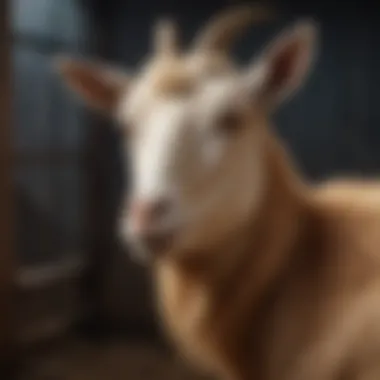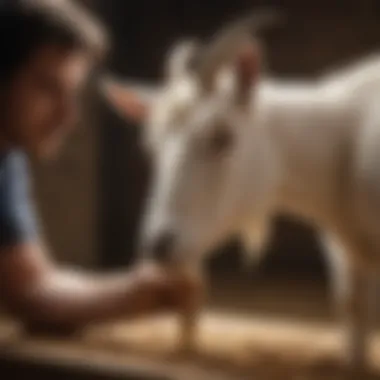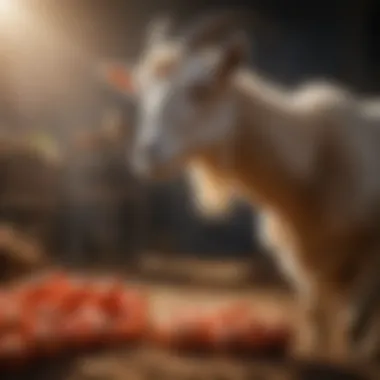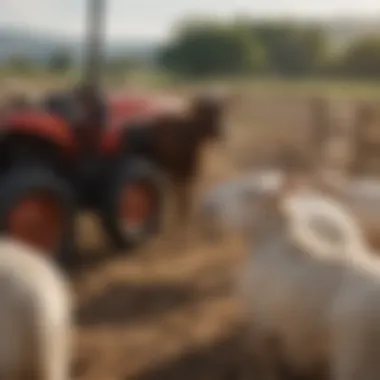Understanding Toltrazuril for Goats: A Comprehensive Guide


Intro
In the realm of goat husbandry, maintaining the health of livestock is paramount. One way to address health challenges in goats is through the use of medications. Among these treatments is toltrazuril, an anti-coccidial drug. This article aims to provide farmers with a deep understanding of toltrazuril, elucidating its mechanism of action, proper administration, potential side effects, and the best practices for sourcing the drug. A focused examination on ways to obtain toltrazuril from Tractor Supply will also be included, enabling farmers to make informed choices for managing their herds.
Understanding toltrazuril aids in ensuring that goats remain healthy and productive, ultimately impacting the overall success of farming operations.
Topic Overview
Definition and Importance
Toltrazuril is a medication primarily used to treat infections caused by coccidia, a type of parasite that can severely affect goats. These infections, if left untreated, can lead to poor growth rates and increased mortality in young animals. The importance of toltrazuril lies in its ability to effectively combat these parasites, thus promoting healthier livestock and better farm productivity.
Brief History and Evolution
The history of toltrazuril dates back to its development in the late 20th century. Initially designed for veterinary use in various species, it has gained prominence in goat farming. Over the years, its efficacy and safety profile have been studied extensively, leading to wider acceptance among veterinarians and farmers. Its introduction has provided a vital tool in the ongoing battle against coccidiosis, a disease that can ravage goat populations if not managed correctly.
Key Techniques and Innovations
Sustainable Farming Practices
Farmers can implement sustainable practices to enhance the effectiveness of toltrazuril in controlling coccidiosis. These practices include:
- Rotational grazing: Helps reduce parasite load in pastures.
- Proper sanitation: Regularly cleaning living areas and feeding equipment minimizes the spread of parasites.
- Nutritional management: Providing balanced diets strengthens goats' immune systems, making them less susceptible to infections.
Advanced Agronomic Technologies
Incorporating technology can also improve overall goat health. For example:
- Monitoring tools: Devices that track herd health can provide early warnings of increasing parasite levels.
- Data analytics: Analyzing health data helps farmers make informed decisions about the timing of toltrazuril administration.
Practical Applications
Step-by-Step Guides
Administering toltrazuril requires accuracy. Typically, the steps include:
- Consulting a veterinarian to confirm that toltrazuril is the correct treatment.
- Calculating the appropriate dosage based on the goat's weight and the specific formulation.
- Administering the medication either orally or through injection, depending on recommendations.
- Monitoring the goats for any side effects and overall health improvement.
Case Studies or Real-World Examples
Numerous farms have successfully integrated toltrazuril into their management protocols. For instance, a dairy goat farm in Wisconsin reported a significant decline in coccidiosis cases after adopting toltrazuril as part of their health regimen. They implemented best practices like pasture rotation and regular health checks, leading to improved milk production as well.
"The proactive use of toltrazuril, combined with sustainable farming practices, has transformed our herd's health. We have seen less illness and better growth rates."
This shows the impact that thoughtful management and appropriate medication can have on goat farming.
By understanding toltrazuril, farmers can enhance their management strategies and ultimately improve the health and productivity of their goats.
Prelude to Toltrazuril
Toltrazuril is a critical compound in the realm of veterinary medicine, particularly in its application to goats. By treating various parasitic infections, it plays a key role in promoting goat health and well-being. The importance of understanding toltrazuril lies in its impact on livestock productivity and, consequently, the economic viability of farming operations. Farmers need a comprehensive grasp of how this medication works, its optimal use, and its potential risks. This knowledge aids in making informed decisions that directly affect the health of their herd.
Definition and Importance


Toltrazuril is an anti-parasitic agent primarily used to combat infections caused by protozoa, especially in young ruminants such as goats. It belongs to a category of products known as toltrazuril sulfonamides, which are often prescribed to prevent and treat coccidiosis—a condition that can severely impact goat health. The administration of toltrazuril provides several benefits. It not only assists in controlling parasitic populations but also minimizes the risk of disease outbreaks that could decimate livestock.
Furthermore, as farming practices evolve and new strains of parasites emerge, having access to effective treatment options like toltrazuril becomes increasingly vital. With proper use, toltrazuril can enhance weight gain and overall productivity in goats. Thus, understanding this medication’s role is essential for any serious goat farmer looking to optimize herd performance and safeguard against health crises.
Historical Background
The development of toltrazuril dates back several decades, with research focusing on effective treatments for parasitic infections in livestock. Before its introduction, farmers often struggled with coccidiosis, which led to significant losses in both health and profit margins. The emergence of toltrazuril marked a turning point in veterinary medicine. As awareness of its potential benefits grew, so did the adoption of this drug in farming practices across various regions.
Research findings that highlighted toltrazuril's efficacy contributed to its increasing popularity. As studies demonstrated its ability to not only treat existing infections but also to reduce the incidence of new cases, it became a go-to medication for many veterinarians. This compounded the need for farmers to familiarize themselves with toltrazuril, solidifying its place in the agricultural landscape. By understanding its historical context, farmers can better appreciate the ongoing developments and importance of toltrazuril in goat management and overall animal health.
Pharmacological Overview of Toltrazuril
The pharmacological overview of toltrazuril is essential in understanding its role in veterinary medicine, particularly for goats. It is significant because toltrazuril targets specific parasites and infections that can severely affect goat health. Understanding the pharmacological aspects helps farmers in making informed decisions about its use in treatment protocols. This section will delve into two main components: its mechanism of action and its chemical composition.
Mechanism of Action
Toltrazuril operates primarily through its action on the cell biology of parasites. It targets the developmental stages of coccidia, which are common protozoan parasites that infect goats. The drug interferes with the synthesis of vital components needed for the growth and reproduction of these parasites. By inhibiting these pathways, toltrazuril effectively reduces the parasitic load, leading to a decrease in symptoms related to coccidiosis.
Research shows that the efficacy of toltrazuril is profound, especially during early stages of infection. This means that effective administration can prevent severe complications, thus promoting better overall health for goats. The absorbed toltrazuril is distributed systemically, ensuring a comprehensive approach to treatment. It is critical for farmers to understand this mechanism as it aids in timely administration, maximizing the drug's impact.
Chemical Composition
Toltrazuril is a sulfonamide derivative with a well-defined chemical structure. Its molecular formula is C130F3N3O4S. Understanding its chemical composition is important for several reasons. First, it guides farmers on storage conditions and shelf life. The stability and degradation of any veterinary drug can vary based on environmental conditions.
Moreover, knowing its composition can help in understanding potential interactions with other medications that may be administered alongside. Medications like monensin or lasalocid, which are also used to manage parasitic infections, might have interactions with toltrazuril. It’s critical for farmers to consult with veterinarians about these risks.
In summary, a thorough grasp of the pharmacological properties of toltrazuril allows for better implementation in goat health management and enhances the chances of successful treatment of coccidiosis.
Administering Toltrazuril to Goats
Administering toltrazuril is a significant aspect when discussing the treatment of goats for coccidiosis and other parasitic infections. Proper administration ensures that the medication is effective and minimizes the chances of adverse reactions. Understanding the right dosage, administration methods, and treatment frequency can significantly enhance the health outcomes for goats in a farming operation. Informed farmers can thus make better decisions regarding their livestock's health.
Dosage Recommendations
Getting toltrazuril dosage right is crucial for its effectiveness in treating goats. The general recommendation often suggests a dosage of 20 mg per kg of body weight. However, it is essential to weigh the goats accurately to calculate the proper dosage precisely. Administering too little can lead to insufficient treatment, while too much can cause toxicity. Moreover, the guidelines from veterinary professionals should always be followed to tailor the dosage according to the specific needs of the goat and the severity of the infection.
Preferred Administration Methods
The method of administration can greatly impact the efficacy of toltrazuril. The two common methods are:
- Oral administration: This is typically the most straightforward method. Toltrazuril can be provided through drenching or mixing it with feed. This method is quite effective, ensuring the goats ingest the entire dose.
- Injection: In cases where oral administration might not be feasible, injections might be preferred. This ensures that the drug enters the bloodstream directly, bypassing potential absorption issues that can arise with oral methods.
Regardless of the method chosen, monitoring the goats after treatment is important to ensure they respond well to the medication.
Frequency of Treatment
The frequency of administering toltrazuril is also a critical consideration. It's commonly advised to restrict treatment to a single dose per treatment cycle, but the overall management plan should consider the following:
- Assessing the infection status: If there is a marked improvement in the goat’s health, further treatments may not be necessary. Alternatively, if symptoms persist, consulting a veterinarian for additional dosing is key.
- Seasonal factors: In some regions, the likelihood of coccidiosis outbreaks can vary with seasons. Understanding the environmental context can guide whether it is necessary to implement additional treatments throughout the year.
Paying attention to these factors allows farmers to create an effective treatment schedule that suits their farming conditions.
Sourcing Toltrazuril at Tractor Supply


Sourcing Toltrazuril at Tractor Supply is crucial for goat farmers. This resource not only influences the availability of essential medications but also impacts the overall management practices for goat health. Knowing where to purchase it helps farmers ensure that their goats receive timely treatment, minimizing the risk of severe health issues associated with coccidiosis and other parasitic infections.
In recent years, there has been a growing awareness of the importance of proper medication for livestock. Having access to toltrazuril from a reputable supplier like Tractor Supply provides reassurance regarding the quality and efficacy of the product. Additionally, procuring medications locally can significantly reduce transportation time and costs, facilitating quicker responses to health concerns.
Available Products
At Tractor Supply, several formulations of toltrazuril are available. Options may include liquid formulations or boluses, designed for straightforward administration. Here are some points to note about the products:
- Liquid Formulations: Often preferred for ease of use, these can be mixed with feed or given directly. The dosing is flexible, allowing adjustments based on the veterinarian’s recommendations.
- Boluses: These are solids that can be easily administered. They may be suitable for farmers who prefer a less messy option or require specific dosages.
- Combination Products: Some products may contain other medications to bolster efficacy against various infections. This is something to look for during the sourcing process.
It is important for farmers to familiarize themselves with the specific brands and concentrations available. Often, the staff at Tractor Supply can provide valuable insights or recommendations based on local practices and needs.
Comparative Pricing
Understanding the comparative pricing of toltrazuril at Tractor Supply is essential for budget-conscious farmers. Prices can vary depending on the formulation and brand. Here are some aspects to consider when evaluating costs:
- Brand Variability: Recognizing the difference in pricing between brands can help farmers make informed decisions. Some brands may offer premium formulations at a higher price, while others might provide basic options.
- Packaging Size: Larger packaging may offer cost savings per unit compared to smaller packages. Farmers should assess their average usage to determine the most economical purchasing choice.
- Seasonal Discounts: Tractor Supply often runs promotions or seasonal sales. Keeping track of these can significantly help in reducing overall spending on livestock medications.
- Comparing Other Suppliers: While sourcing at Tractor Supply, it is also wise to compare prices with local veterinary suppliers or online options. This creates opportunity for better deals or exclusive offers.
"A thorough knowledge of available products and their pricing can enhance a farmer's capacity to make sound purchasing decisions for goat health management."
Efficacy of Toltrazuril in Treating Goats
The efficacy of toltrazuril as a treatment for goats is crucial for farmers aiming to maintain optimal health in their livestock. Understanding how well this drug performs not only aids in managing health issues but also enhances overall farm productivity. Its targeted action against protozoal infections has made it a key component in veterinary medicine for small ruminants. The significance of toltrazuril lies in its ability to effectively combat coccidiosis, a prevalent disease that affects goat populations. Farmers who incorporate toltrazuril into their health management strategies can expect improved weight gain, better feed utilization, and reduced mortality rates among affected animals.
Clinical Studies Overview
Several clinical studies have evaluated the efficacy of toltrazuril in treating goats. In one prominent study, the treatment was administered to goats infected with Eimeria, a common coccidia genus. The results indicated a significant reduction in oocyst shedding post-treatment, leading to a decrease in clinical signs associated with coccidiosis. This is important as high levels of oocysts in the environment can perpetuate the cycle of reinfection within a herd. Moreover, subsequent research found that goats treated with toltrazuril demonstrated improved growth rates compared to untreated groups, illustrating its effectiveness in promoting recovery after infection. Further research continues to support the drug's role in managing not only coccidiosis but also its impact on reducing overall veterinary costs associated with treating severe infections.
Common Infections Targeted
Toltrazuril primarily targets Eimeria species, which cause coccidiosis in goats. This condition is characterized by diarrhea, weight loss, and dehydration, significantly impacting a goat's health and productivity. Besides Eimeria, some data suggest that toltrazuril might have beneficial effects on other protozoal infections, although its primary use remains in coccidiosis management. The advantage of using toltrazuril lies in its broad-spectrum activity against various developmental stages of Eimeria, allowing effective control over multiple types of infection simultaneously. Maintaining a proactive treatment plan with toltrazuril can lead to healthier herds and potentially higher profitability for goat farmers.
Potential Side Effects and Risks
Understanding the potential side effects and associated risks when administering toltrazuril to goats is crucial for any farmer or veterinary professional. Knowledge of these factors ensures informed decision-making about treatments, maximizing therapeutic benefits while minimizing adverse outcomes. Monitoring goat wellness and promptly addressing side effects can prevent further complications, maintaining both animal health and farm productivity.
Common Adverse Reactions
While toltrazuril is generally well-tolerated, some goats may experience adverse reactions. The common side effects associated with toltrazuril can include:
- Loss of appetite
- Mild diarrhea
- Lethargy
- Vomiting
- Allergic reactions, though rare
These reactions may vary in severity and can depend on individual goat sensitivity and underlying health conditions. It's essential for farmers to observe their animals closely after treatment. Identifying any unexpected behaviors or physical symptoms can lead to timely interventions if necessary.
Measures to Mitigate Risks
Farmers can employ several strategies to reduce risks associated with toltrazuril usage. These include:
- Gradual Introduction: Start treatment with a lower dose, gradually increasing it to help the goat adjust.
- Hydration: Ensure that goats remain well-hydrated, particularly if diarrhea occurs.
- Regular Monitoring: Keep a close eye on the goats' health during and after treatment. Document any changes in behavior or physical condition.
- Consultation: Engage a veterinarian for guidelines tailored to specific breeds or individual health concerns.
Prioritizing animal welfare ultimately aids in the successful management of goat health, enhancing therapeutic outcomes related to toltrazuril use.
By taking these precautions, farmers can safeguard against complications, ensuring the well-being and productivity of their livestock.


Best Practices for Goat Health Management
Managing goat health effectively requires a holistic approach. Best practices are essential to ensure the well-being of goats while optimizing their production. These methods play a significant role in promoting longevity, productivity, and overall health. Farmers must focus on integrated health approaches and monitoring goat condition to sustain healthy herds.
Integrated Health Approaches
Integrated health approaches combine various strategies that contribute to the overall health of goats. This method includes nutritional management, regular veterinary check-ups, and vaccination protocols. By addressing multiple aspects of goat care, farmers can create a more robust health framework.
- Nutritional Management: Proper nutrition is the foundation of goat health. A balanced diet contributes to growth and reproductive performance. Farmers should ensure goats have access to high-quality forage, grains, and minerals.
- Veterinary Care: Regular visits from a veterinarian ensures that any health issues are addressed promptly. Farmers should establish a health plan tailored to the specific needs of their herd. This includes vaccinations and deworming schedules that prevent diseases effectively.
- Biosecurity Measures: To prevent the introduction of pathogens, farmers should implement strong biosecurity measures. This includes quarantining new arrivals and maintaining cleanliness in the environment.
Incorporating these practices leads to improved health outcomes and reduced treatment costs in the long run. The focus on a comprehensive health management strategy empowers farmers to mitigate risks efficiently.
Monitoring Goat Condition
Monitoring goat condition is crucial for early detection of health issues. Regular assessments can significantly influence the response to potential problems. Farmers should observe behavioral changes, weight fluctuations, and overall appearance. This level of vigilance helps in making informed decisions regarding health interventions.
- Weight Tracking: Regularly weighing goats provides insight into their growth and nutritional status. Sudden weight loss may indicate health issues.
- Body Condition Scoring: Implementing a body condition scoring system allows farmers to assess fat coverage and muscling. A score of 1 indicates emaciation, while a score of 5 signals obesity. The ideal score for breeding stock is around 3.
- Behavioral Observations: Changes in behavior, such as isolation from the herd or decreased appetite, can signal illness. Farmers should note any deviations from normal behavior for timely interventions.
"Regular monitoring of goats not only helps identify health problems early, but also supports optimal management practices."
Monitoring goat condition effectively can lead to better herd management outcomes. It helps in adjusting feeding strategies, administering treatments, and enhancing overall care strategies. By employing these best practices, farmers can ensure a healthier, more productive goat population.
Regulatory Considerations
Understanding the regulatory landscape surrounding toltrazuril's use in goats is crucial. This section addresses two primary aspects: the approval status of toltrazuril in various regions, and its associated withdrawal times before consumption. Compliance with regulations ensures the safe use of medication in livestock, thus protecting both animal welfare and consumer health. By knowing the legal aspects, farmers can make informed choices that align with best practices in goat management.
Approval Status in Various Regions
Regulatory approvals for toltrazuril can differ greatly across countries and regions. In many countries, toltrazuril has received approval as an antiprotozoal medication for goats, primarily targeting Coccidia infections. The approval process usually involves rigorous evaluation by regulatory bodies such as the European Medicines Agency (EMA) in Europe, or the United States Food and Drug Administration (FDA).
- European Union: Toltrazuril is approved for use in various livestock, including goats. Its safety and efficacy have been established through extensive studies.
- United States: Toltrazuril is not yet widely approved for use in goats. Farmers often rely on available alternatives to manage coccidiosis.
- Australia: The approval status varies by state, and some regions have included toltrazuril in their veterinary pharmaceuticals.
It is important for farmers to stay updated on the regulatory framework in their area, as any changes can impact treatment practices.
Withdrawal Times Before Slaughter
Withdrawal times refer to the duration that must pass after medication is administered before the animal can be slaughtered for human consumption. This is a critical aspect of livestock management. For toltrazuril, it is essential to follow the guidelines provided by veterinary authorities.
- Common Practice: In general, the withdrawal period for toltrazuril in goats is often set at a minimum of 5 to 10 days, depending on specific formulation and dosage.
- Individual Variation: Each animal may metabolize medications differently, so monitoring and consulting with a veterinarian is advisable to determine the safest withdrawal time.
Important Note: Always check with local regulations for specific withdrawal guidelines, as they can vary significantly by region and product.
By adhering to these withdrawal times, farmers not only comply with regulations but also ensure the safety of the meat products they produce, preserving the trust of consumers in their farming practices.
Closure and Future Perspectives
Evaluating the regulatory landscape and ongoing research will also be crucial. Adaptation to emerging trends and studies will keep farmers well-positioned to employ toltrazuril effectively. By making informed choices regarding this treatment, goat owners can manage their livestock's health with greater confidence. Additionally, the insights gathered here demand attention, reflecting a collective effort to enhance the standards of goat husbandry.
Recap of Key Points
This article discussed several core aspects regarding toltrazuril:
- Definition and Importance: Toltrazuril serves as an effective antiparasitic agent for goats, critical in managing infections.
- Mechanism and Pharmacology: The mechanism of action targets specific parasites, cutting down on their reproduction and viability.
- Administration Guidelines: Proper dosing and preferred administration methods are essential for maximizing effectiveness.
- Efficacy and Side Effects: Clinical studies demonstrate its success, yet awareness of potential side effects remains necessary.
- Regulatory Aspects: Understanding the drug's status and withdrawal times helps ensure compliance with agricultural standards.
Emerging Research Directions
Looking forward, several areas merit further investigation within the context of toltrazuril for goats:
- Resistance Patterns: Research into potential resistance development among parasites is crucial to maintain the drug's efficacy.
- Long-Term Outcomes: Further studies on the long-term health impacts of toltrazuril treatment on goat herds could inform better management practices.
- Integrated Health Approaches: Combining toltrazuril treatment with holistic health management strategies is an interesting direction for ensuring sustainable livestock health.
- Distribution and Availability: Analysis of supply chains to ensure equitable access to toltrazuril among farmers could enhance overall goat health management.
Future research shall contribute depth to the field, ensuring that the application and understanding of toltrazuril continue to evolve in alignment with changing agricultural needs. Farmers equipped with up-to-date insights and practical guidance will be better positioned to maintain the health of their goat populations.



